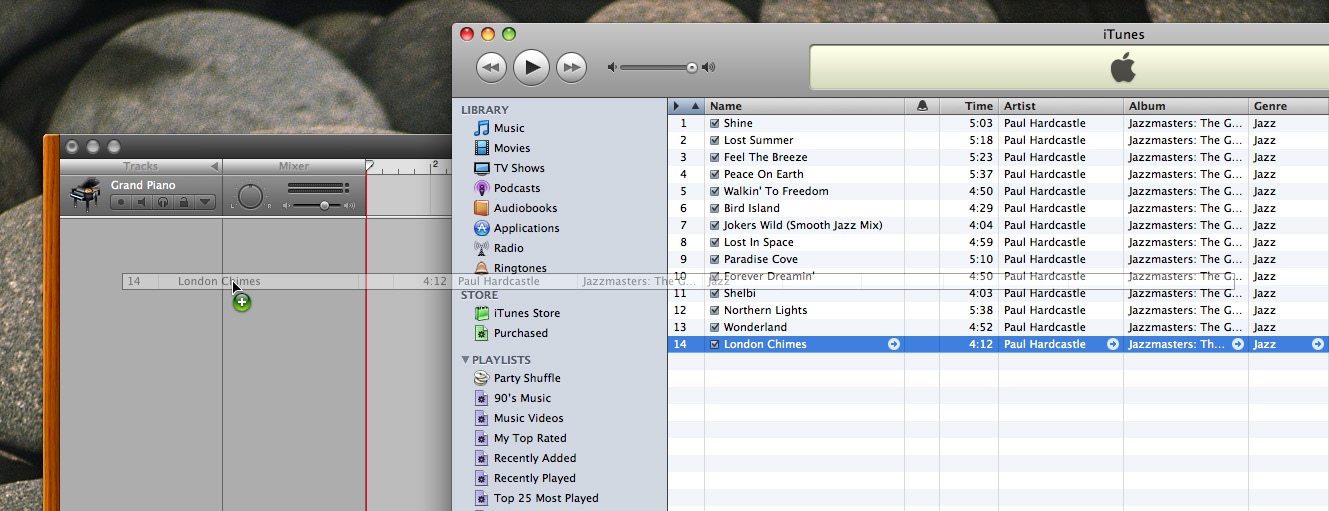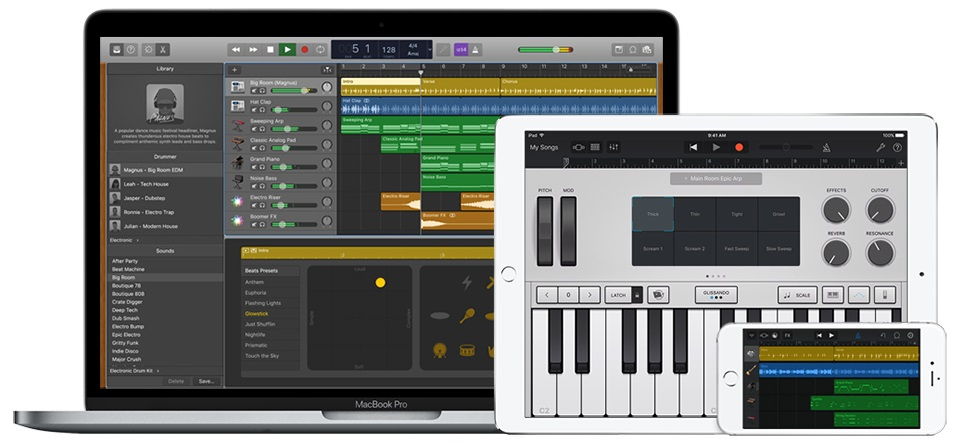oodji.netlify.app
Command Option G Garageband
Option + Down Arrow: Transpose selected notes down one semitone: Option + Shift + Up Arrow: Transpose selected notes up one octave: Option + Shift + Down Arrow: Transpose selected notes down one octave: Right Arrow: Select the next score event: Left Arrow: Select the previous score event: Down Arrow: Select the next staff event: Up Arrow: Select the previous staff event: Command.
Izotope idrum que es. IDrum turns your Mac or PC into a powerful and flexible virtual drum machine. Inspired by both vintage and modern-day hardware, iDrum was designed from the ground up to capture the same feel in software form. The result is an indispensable, easy-to-use tool that is also a blast to use. May 16, 2018 My review of iZotope iDrum. Someone asked me how it worked. Feel free to comment below with any questions about this video or ideas for future videos! Apr 23, 2014 All in all, iZotope iDrum is a handy software application for musicians in search of creating the perfect drum beat. The utility did not display any errors during testing and has a minimal system.
Snow Leopard is one of Mac’s leading operating systems that support and fixes all latest devices. A sleeker user interfaces with a clean environment for users to enjoy the functionality without problems.  The design of this operating system specifically pays attention to security. There are also several improvements and fixes to make this OS better than the previous versions.
The design of this operating system specifically pays attention to security. There are also several improvements and fixes to make this OS better than the previous versions.

The DoorPost - GarageBand tips newsletter is sent to you every three months and is full of extra tips on how to get the most out of GarageBand. It takes a more in-depth look at some important aspects of digital audio and home recording with GarageBand. Also: Links to. Use Garageband Shortcuts to make music and podcasts in macOS and iOS devices. Download Garageband Shortcuts PDF Now. It is digital audio workstation. Garageband Keyboard Shortcuts. Start or stop playback. Go to beginning. Go to end of last region. Move forward. Period (.) Move back. Comma (,) Move forward by cycle area length. Shift-Command-Period (.) Move back by cycle area length. Press Command-Shift-4 to take a screenshot of a selected area of the screen. Press Command-Shift-6 to capture the Touch Bar (if applicable). If you switched to the Mac from a PC, check out the Apple Support article Mac tips for Windows switchers for a list of Mac keyboard shortcuts and the differences between Mac and Windows keyboards. GOption groups options in GOptionGroups, which makes it easy to incorporate options from multiple sources.The intended use for this is to let applications collect option groups from the libraries it uses, add them to their GOptionContext, and parse all options by a single call to goptioncontextparse.See gtkgetoptiongroup for an example. If an option is declared to be of type string. Play and Record in GarageBand with Keyboard Shortcuts. GarageBand, which comes with iLife ’11, gives you great flexibility for recording and playing back songs, dialog, or whatever you want to record. But with great flexibility comes options, options you can execute quickly in GarageBand with the following keyboard shortcuts.
MacBook owners have a number of tools that come in very handy for using their laptops efficiently and for maintaining the operating system to keep it running in top shape. These MacBook keyboard shortcuts for the Finder, a maintenance checklist, and a “translation” of the modifier keys will speed you on your way to becoming a MacBook power user.
Command Option G Garageband 10
Mac OS X Finder Keyboard Shortcuts
The Mac OS X Lion Finder helps you access and organize most of the important Mac OS X functions while you work. Use Finder keyboard shortcuts to display windows, copy and move files, and launch applications. These keyboard shortcuts help you get things done more efficiently.

| Key | Function |
|---|---|
| Command+A | Selects all items in the active window (icon view), all items in the column (column view), or all items in the list (cover flow view) |
| Command+C | Copies selected items |
| Command+D | Duplicates the selected item(s) |
| Command+E | Ejects the selected volume |
| Command+F | Displays the Find dialog |
| Command+H | Hides All Finder windows |
| Command+I | Shows info for selected item or items |
| Command+J | Shows the view options for the active window |
| Command+K | Displays the Connect to Server dialog |
| Command+L | Creates an alias for the selected item |
| Command+M | Minimizes the active window |
| Command+N | Opens a new Finder window |
| Command+O | Opens (or launches) the selected item |
| Command+R | Shows the original for selected alias |
| Command+T | Adds the selected item to the Sidebar |
| Command+V | Pastes items from the Clipboard |
| Command+W | Closes the active window |
| Command+X | Cuts the selected items |
| Command+Z | Undoes the last action (if possible) |
| Command+, | Displays Finder Preferences |
| Command+1 | Shows the active window in icon mode |
| Command+2 | Shows the active window in list mode |
| Command+3 | Shows the active window in column mode |
| Command+4 | Shows the active window in cover flow mode |
| Command+[ | Moves back to the previous Finder location |
| Command+] | Moves forward to the next Finder location |
| Command+Del | Moves selected items to the Trash |
| Command+up-arrow | Show enclosing folder |
| Command+` | Cycles through windows |
| Command+? | Displays the Mac OS X Help Viewer |
| Command+Shift+A | Takes you to your Applications folder |
| Command+Shift+C | Takes you to the top-level Computer location |
| Command+Shift+G | Takes you to a folder that you specify |
| Command+Shift+H | Takes you to your Home folder |
| Command+Shift+I | Connects you to your iDisk |
| Command+Shift+Q | Logs you out |
| Command+Shift+N | Creates a new untitled folder in the active window |
| Command+Shift+U | Takes you to your Utilities folder |
| Command+Shift+Del | Deletes the contents of the Trash |
| Command+Option+H | Hides all windows except the Finder’s window(s) |
| Command+Option+N | Creates a new Smart Folder |
| Command+Option+T | Hides the Finder window toolbar |
| Command+Option+Space | Opens the Spotlight window |
| Command+Space | Opens the Spotlight menu |
| F8 | Choose another desktop using Spaces |
| Control+up-arrow (or F3, depending on your keyboard model) | Displays the Mission Control screen |
| Control+down-arrow (or Control+F3, depending on your keyboard model) | Shows all open windows for the current application using Mission Control |
| F11 (or Command+F3, depending on your keyboard model) | Hides all windows to display the Desktop using Mission Control |
| F12 (or F4, depending on your keyboard model) | Displays your Dashboard widgets |
| Space | Quick Look |
Strange-Looking Keys on the MacBook Keyboard
New to the Macintosh world? Some keys on the MacBook keyboard may be mystifying. Whether you’re using Snow Leopard or an older version of Mac OS X, recognizing and using modifier keys will make your job easier. Here’s a look at the modifier keys on both MacBook and desktop keyboards:
Command Option G Garageband Download
Mac OS X Maintenance Checklist
Maintenance is vital if you want to keep Mac OS X Lion in tip-top condition for as long as possible. Maintaining your MacBook keeps it running fast and smooth. Basic housekeeping includes regular back-ups plus some other, less familiar, tasks. Check this table often, or print it and keep a copy near your laptop!
Command Option G Garageband Free
| Mac Maintenance Task | Schedule |
|---|---|
| Check for updates with Software Update | Once a day (automatic setting) |
| Back up with Time Machine | Automatic |
| Defragment (Micromat TechTool Pro/Prosoft Engineering Drive Genius 3) | Once a week |
| Repair Disk Permissions (Disk Utility) | Once a week |
| Delete Unnecessary User Accounts (System Preferences) | As necessary |
| Scan for viruses (Intego VirusBarrier X6, ClamXav 2) | Automatic |
| Check all volumes (Disk Utility/ Micromat TechTool Pro) | Once a week |
| Check for the latest drivers for your hardware | Once a month (or after installing new hardware) |
| Delete temporary Internet cache files (Prosoft Engineering Drive Genius 3) | Once a month |